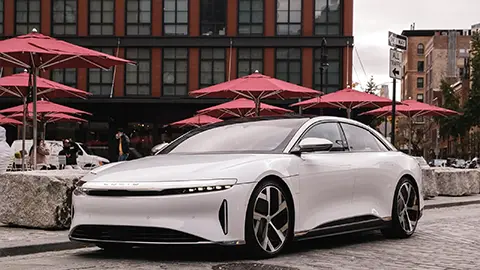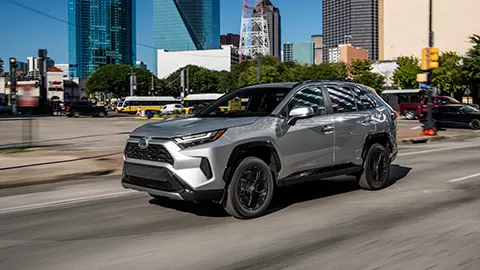How Do You Prepare Your EV for Winter Driving?
Now that you have the right electric vehicle – read our recommendations for how to choose a winter-friendly EV here – let’s get ready for the best winter driving experience. These tips will help you avoid expensive repair costs, be more efficient, spend less time waiting around charging, and be safer overall in the winter.
Tip #1: Buy and Maintain Winter Tires
Whether your car is all-wheel drive (AWD) or not, winter tires usually have the biggest impact when driving in wintry conditions. If you don’t have traction it doesn’t matter how many wheels you have – best case, you’re going nowhere fast. Remember, tires are the only part of your car in contact with the road. You wouldn’t go hike a snowy mountain trail in sandals would you? Sure it’s an absurd analogy, but it’s more accurate than you’d think.
EVs have a lower center of gravity because the battery weight is situated low in the car between the axles. The weight’s location in the car helps put the tires in better contact with the road and gives you more control. This means that any EV will do very well in poor conditions if it has winter tires.
In the U.S. it’s likely that your car will be delivered with all-season or even summer tires. While normal winter tires are n safer in winter conditions, there are now EV-specific winter tires. These tires are designed to be quiet, more efficient than traditional winter tires, and all-around optimized for EVs. Remember when buying wheels for your new tires, less weight means more efficiency and better handling. There are now aero-optimized wheels and wheel covers that are designed to give you an additional 3-5% percent of range.
Also be sure to keep your new tires properly inflated because they are likely to lose their pressure quicker in the cold. According to the U.S. Department of Energy, underinflation can have a 3% impact on efficiency. This means almost 10% of an EV’s range can be impacted by just your wheels and tires.

Tip #2: Precondition Your EV’s Battery for Charging
Preconditioning your car’s battery means that the car warms up your battery, allowing it to accept energy more efficiently. For daily driving, this means that you will be warming up your car’s battery while it’s plugged into the charger. When you warm up your EV before getting in - which you can do through your car’s infotainment system or phone app - you are using the power from your charger (the grid), rather than from the battery, which means more power in your battery for driving.
For road tripping, where you need to stop to DC fast charge along your route, preconditioning your battery means that your charging stops will be a lot shorter and that your battery will charge faster. Researching whether your car has battery preconditioning mode for fast charging and how to turn it on will save you lots of time during those long, cold road trips!
Tip #3: Know Your Car’s Cold Weather Settings
Make sure you know how to adjust relevant weather driving settings in your car like putting it in an eco-mode, snow mode (if it has one), and lowering the amount of regenerative braking to help prevent your car from sliding.
Using heated seats in addition to lowering the cabin heater temperature will lower your car’s overall energy usage - which lets you be more efficient so your car will go farther (and with modern heated seats you’ll probably be even warmer this way too).
Tip #4: Consider Upgrades Like Paint Protection Film, Mud Flaps and Snow Chains
Mud flaps may slightly impact aero efficiency, but they’ll help with making sure cameras or other driver assistance hardware don't get blocked by snow or other winter muck shot up by the tires. Plus they are a good way to avoid angering other drivers on the road by preventing rock chips to their windows.
Paint protection film can be spendy, but along with mud flaps, it will save money by minimizing damage to the side of your car from rock chips. And in the worst of winter conditions, having snow chains to put on your tires (even if they are studded winter tires) is the best way to be prepared for winter driving. Check your local and regional regulations.

Tip #5: Always Be Prepared
It’s the Boy Scout motto for a reason. Now that you and your EV are ready for the next big blizzard, it unfortunately doesn’t mean others are. An ice scraper, an extra coat or blanket, extra water (especially if you’re going on a longer road trip) and an emergency kit with first aid items are things you should keep in your car during the winter. These things could help not only yourself and your passengers, but could be the difference in saving someone else’s life when it’s cold out.
Tip #6: Do a Pre-Flight Check
Pilots are responsible for checking their plane before takeoff. You might not be flying through the Arctic Circle, but the few extra seconds to check around your car are a lot quicker (and cheaper) than a hospital visit. If you regularly park your car outside, be aware that because EVs don’t have an engine under the hood and LED lights are more efficient (and generally run cooler) than traditional light bulbs, snow can build up on the front of the car and block your lights. Having an ice scraper (or brush to avoid scratches) for removing snow around lights will greatly increase how well you can see the road and how well others see you.
We hope these tips on cold weather driving will help you be prepared for what the roads might throw at you. If you're looking to find the perfect EV for the winter, you can find some great tips here.
















